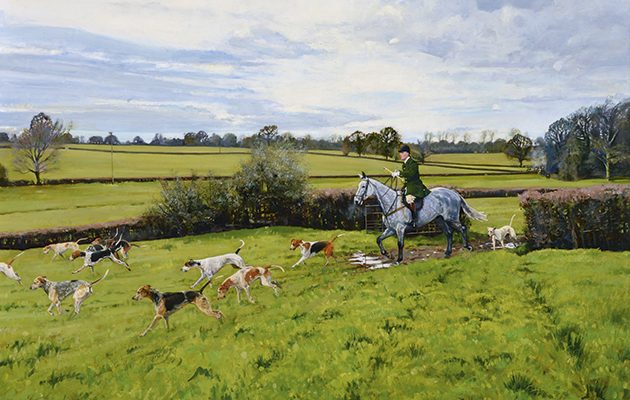Tristram Lewis explains to Janet Menzies why he has swapped paintbrush for Plasticine to immortalise a great racehorse in bronze
Inspired by Munnings from a young age, Tristram Lewis tells Janet Menzies why he swapped his paintbrush for Plasticine to immortalise a great racehorse in bronze.
For more sporting art, Zaza Shelley‘s hallmark is meticulous preparation and the work of Kate Brooks is full of character but never anthropomorphised.
TRISTRAM LEWIS
Once in a while a racehorse comes along that inspires far beyond the fleeting moment of victory on the course. Denman was such a horse. As a chaser he won at the top level, including the Cheltenham Gold Cup and two Hennessy Gold Cups at Newbury. But it was his epic rivalry with Kauto Star that captured the public’s imagination. Both trained by Paul Nicholls, Kauto Star was the class act with Denman, “The Tank”, in the role of the people’s battler. Football scarves were knitted in their racing colours so fans could declare their allegiance.

Tristram Lewis’ bronze of the racehorse Denman.
Now 17 years old, in happy retirement on the hunting field where his tank-like ability to get over or, if necessary, through any obstacle is much valued, Denman continues to inspire. Equestrian artist and sculptor Tristram Lewis will be unveiling his new bronze of Denman at the Osborne Studio Gallery to coincide with the Cheltenham Festival, where Denman and his supporters enjoyed so many glory days.
The inspiration for the bronze goes back to another legendary racehorse, Brown Jack, and the bronze of him by Sir Alfred Munnings. “Munnings is best known as an equestrian painter but he sculpted as well and one he did was of Brown Jack, who won at Royal Ascot for six years in succession. The Jockey Club commissioned Munnings to do the sculpture in 1935. When I first saw this bronze, it was an inspiration to me. I thought, well, I’m never going to have a Munnings’ Brown Jack so I had better make one.”

With the real Denman.
Accordingly, Tristram Lewis set to work on his first equestrian sculpture. “I began to make the model and I just had kids’ Plasticine, so the model was multicoloured but I got it done and the family liked it, and it looked like a horse. We decided it would be worth getting it cast by Castle Fine Arts foundry, which made the mould and cast three bronzes. I kept one and Osborne Studio Gallery took the other two. That was what got me going.”
Lewis’s near obsession with the work of Munnings has been the constant factor in a life of excitement, much of it spent either on the back of a horse or on the ocean waves as the owner/operator of a tuna fleet.
Lewis remembers: “My mother was an artist and my parents began married life in Chelsea, in that Chelsea Arts Club set, so art was always in the air. Then, on my 17th birthday, I got a card of Munnings’s painting Clearing the Hedge. That inspired a passion for Munnings that has stayed with me throughout life. I have been researching and writing a big book about him, which is soon to be published by the Royal Academy – I’m particularly pleased about this as Munnings had in fact fallen out with the Academy during his life, although he had been President at one stage.”

Tristram Lewis at home.
Now able to pursue equestrian art full time, one of Lewis’s early commissions was a mounted portrait of Tony Holdsworth outside Badminton House to commemorate his retirement as the Beaufort huntsman. This was important to Lewis as he and his sons hunt regularly with the Beaufort. “The Beaufort is such an historic pack, with beautiful country from the artist’s point of view. Only the other day we were coming home from hunting and happened to be hacking back in front of Badminton House across the park when hounds came screaming into view. Suddenly, we found ourselves hunting again.”
For an artist, such memories linger as visual images. Capturing them on canvas evokes the atmosphere of the moment all the more strongly because artists such as Lewis and his inspiration, Munnings, have experienced them in real life. This is something Denman’s original joint-owner, Paul Barber, recognised when he saw Lewis’s maquette of the statue. “I felt I needed to get Mr Barber’s approval for the statue,” explains Lewis, “so I took it down to Somerset. The statue is a little larger than my previous works, at 26 inches, because Denman is a big horse with a really strong physical presence and I wanted to portray that. When I showed it to Paul he said, ‘Yes, that is Denman,’ and instinctively began to stroke the model. That was a special moment. The next plan now is to see if we can get a life-size version onto Newbury Racecourse, where Denman had his record-breaking victories.”





